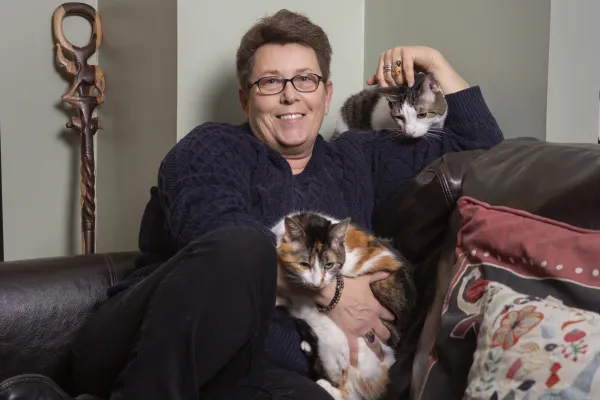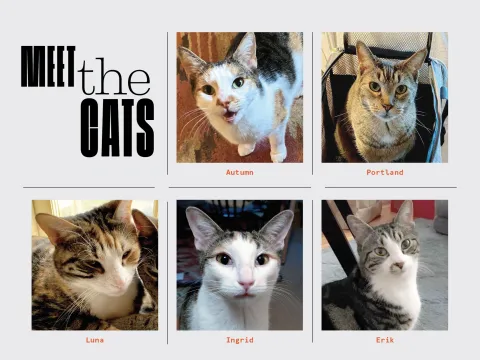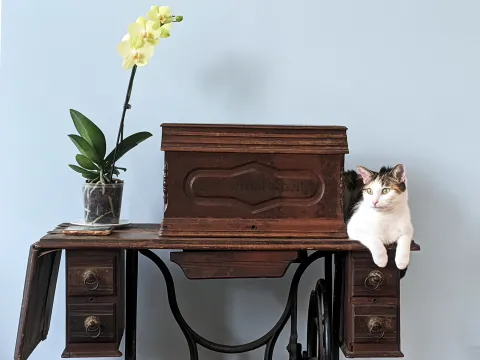E-meow-gency!
Alumnae News
5 cats, 9 states, 18 volunteers, 1 purrfect story—the amazing lengths to which a Facebook group of cat-loving Smithies went to save a fellow alum’s feline family.

Published January 5, 2022
It was the start of another week, and the private Facebook cat group was purring along. Smithies posted funny cat memes and adorable photos of their furry friends.
Then, a new message appeared. It was from an alum in Boston. “I desperately need help...”
The post would galvanize the almost 2,000-strong group. Hundreds of Smithies would like and comment. Still others would begin organizing detailed spreadsheets and Google maps. A dozen Smithies would jump in their cars and drive, sometimes for hours and across multiple states, braving the ongoing pandemic. A few more would suddenly open their homes—and hearts—to new feline family members.
Before that story could begin, though, another tragic one had to unfold. It started in North Carolina with a smart, quiet artist who loved dreamy New England landscape paintings, the idea of escaping to the Southwest, and animals.
Her name was Barbara Erickson. She was not a Smithie. She had never, in fact, been to college. Instead, she married, had a daughter, married again, and moved to the South. Though she fell on hard times after her divorce, she could always find just enough: enough room to save a litter of unwanted kittens, enough food to feed the hungry strays that came to her door, enough medicines to keep her pets healthy and well.
“When she was struggling for money, whenever I could, I would help. She often wouldn’t tell me,” says Kris Erickson AC ’99 of her mother. “She would feed the cats before she would buy food for herself.”
Kris left home at the age of 16, did a brief stint in the Army, and worked as a veterinary technician before applying to Smith as an Ada Comstock Scholar. A first-generation college student, she arrived in Northampton at age 29 with $200 cash and a maxed-out credit card. She would graduate in English language and literature with honors and would go on to earn two master’s degrees and a doctorate before starting a job as an assistant professor at Simmons College in Boston.
Smith “changed the whole trajectory of my life,” she says.
Through it all, one of her biggest cheerleaders was her mother. Barbara still lived in a little apartment in North Carolina. She had five cats: Autumn, Portland, Luna, Ingrid, and Erik. And she had begun hiding a terrible secret from her daughter. By the time Kris realized how ill her mother had become, it was too late. A wellness check brought to light the heart-wrenching diagnosis: stage 4 small-cell carcinoma. Barbara moved to a nursing care facility and declined any treatment. Two days after arriving in North Carolina, Kris held her mother as she passed away.
Kris now believes that her mother didn’t seek help—not because she didn’t think she needed any, but simply because she could not, and would not, contemplate leaving her cats.
Rocked by the suddenness of her mother’s passing and pressed for time when it came to emptying out Barbara’s rental, Kris was left with the question of what to do with her mother’s beloved pets: Autumn, a grumpy calico and the oldest of the five; Portland, a playful tabby with a white blaze across his chest; young, gray-striped Luna, who could often be found cuddling with Portland; chatty, rambunctious, attention-seeking Ingrid; and shy young Erik.

At home, Kris already had a menagerie: two cats—Nutmeg and Schatzi, siblings of Autumn—plus a dog, three goats, and four ducks. “I would have loved to have had [Autumn] here—any or all of them, really—but it just wasn’t feasible.”
Kris started making calls. All the no-kill shelters within a three-hour radius were full. No one could take the cats. “I was so desperate,” Kris says. “I wanted so badly for them to go to good homes.” That’s when she turned to Facebook for help, seeking out a Smith group where caring for cats is the name of the game.
Smithies Who Love Cats, or SWLC, was created in January 2018 by Cat Stolz ’05. Full of cat pictures and memes, the group has since developed a small but devoted following, the majority of whom have—or recently had, or aspire to have—cats of their own.
When Kris Erickson put out the call, volunteers quickly appeared.
Among them was Alison Montgomery ’10, for whom Erickson’s plea struck a deeply personal chord: At the height of the pandemic, SWLC had helped to rehome her godfather’s two cats when he passed away at age 87.
For Montgomery, helping Erickson was an opportunity to pay the rehoming effort forward. She would end up taking the longest transport leg, driving almost seven hours crisscrossing North Carolina before heading up to Maryland.
“Sometimes I think Smithies are magical,” Montgomery says. “We’re going to get it done.”
Stay-at-home parent Carole Anzovin ’00, who describes the group as a “pure delight,” realized there was an opportunity to connect cats in need with potential owners she knew—specifically her brother, Jon. He and his family had recently moved to a new house in Ithaca, New York, and they agreed to adopt the bonded pair of Portland and Luna if someone could get the cats to the Finger Lakes region of New York.
Autumn found a new home in Maine with a Smithie’s parent, while Erik was headed to Boston to live with biochemist Maja Razlog ’97. Razlog’s only previous pet experience had been a short-lived canary, so she was surprised to find herself signing on to cat ownership. “I always knew I wanted a gray tabby. Erik was a gray tabby, so my heart was set.”
Ingrid was the last cat to be claimed. Placing her became the particular project of Valerie Johnson ’02, a university professor in Alabama. As a cat fosterer and advocate, Johnson had been on the front lines of the ongoing battle, particularly in Southern states, to reduce feral cat populations with neuter-and-release efforts. (Kittens young enough to be socialized are put up for adoption.)
“Sometimes I think Smithies are magical,” Montgomery says. “We’re going to get it done.”
Over the past few years, Johnson had adopted five cats of her own and had fostered over a dozen more. “My life isn’t complete without a cat,” she says.
When she saw Erickson’s post, she started messaging graduate school connections, looking for a home for Ingrid. After two days, her work paid off: Her friend Shannon Meyer in Durham, North Carolina, was interested in adopting Ingrid.
Meyer had been mourning the death of her much-loved “grumpy old lady cat” when her 5-year-old orange tabby, Al, went missing. Feeling as though she had a “home for cats with no cat in it,” Meyer offered to take Ingrid. (Al, an outdoor cat, would apparently tire of his long bout of wanderlust and reappear the day Ingrid arrived.)
To Erickson, the effort seemed akin to a miracle: Within 48 hours, all five cats had new homes.

Ingrid makes herself comfortable at her new home in Durham, North Carolina. | Photograph by Shannon Meyer.
The next phase of the project involved figuring out how to move the felines rapidly across the country—and during a pandemic, too. Enter librarian Rachel Sperling ’02. Having two cats herself, Sperling had long found the Smithie group to be a “haven amid all the craziness that is social media.”
Sperling, who had previously worked for an animal rescue group in Minnesota, was no stranger to animal transfer trips. She set up a Google map, a shared spreadsheet, and a set of logistics timed so precisely that volunteers, after driving for hours, often showed up within seconds of one another.
“Even though I didn’t really know any of the Smithies that I worked with on this transport, there’s always that Smith connection,” she says. “We were all looking out for our sibling.”
On a beautiful, clear spring Saturday, the Smithie volunteers loaded up. Some started off at 6 a.m., while others bided their time, checking the progress of the cats via a chat group.
Among those heading out was Rosemary Ripley ’96, who had a deep love for rescue animals and felt compelled by Erickson’s post. Besides, she noted, “I had a car and a tank full of gas.”
Also up for the transport challenge was Tricia Roche McKinney ’88, who saw it as a “safe adventure” with a real impact. She took her daughter along for the three-hour ride between New Jersey and New York.
The volunteers would drive to duplexes and town homes, to a Wegmans and a Walgreens and a Cracker Barrel. They would talk to the cats, comfort them, and feed them treats. Almost all would report how quiet their charges were.
Erickson was among the first to set out, having loaded up the crates and gathered the cats’ favorite foods. Heading east from her mother’s apartment, she drove two hours with Ingrid, Autumn, and Erik before handing them off to Montgomery for the trip to Durham, North Carolina, and then Maryland.
As Montgomery headed north, she reported back to the group: Autumn and Erik appeared to be bonded. She posted photos, too. Then, a surprising message popped up from the Maine destination: Did Razlog want to adopt Autumn as well? Razlog quickly got the green light from her condo association.
Back home, Erickson followed updates on the Facebook page throughout the day. “The journey begins!” wrote Alex Widstrand ’17, driving from Maryland to Pennsylvania. “The NJ handoff a few moments ago! They continue their journey!” wrote Lisa Dowd Pedicone ’89 on the next leg.
From New Jersey to Connecticut, from Connecticut to New York, from New York to Massachusetts, the cats traveled—napping, stretching, and peering out shyly—oblivious to the fact that hundreds of Facebook fans were cheering for them.
“It felt like the whole community was hanging on to this story while it was happening,” Erickson says.
By Sunday night, it was all over. Erik and Autumn were settling in with new cat owner Razlog in Massachusetts. Ingrid was meeting her new brother—the wandering Al—in North Carolina. Portland and Luna were poking their noses out of their crates at their new lakeside home in upstate New York.
The experience, coupled as it is with her mother’s passing, still makes Erickson well up with emotion.
“I’ve always felt this community to be very strong. I always bragged to my friends and people I know that if I was teleported and dropped into a foreign land, I literally could call a Smithie and I’d have a place to stay,” she says, wiping away tears.
“They were all strangers, and yet they were all family.”
Rachael Hanley Hagerstrom ’02 is Smith’s social media manager.
This story appears in the Winter 2022 issue of the Smith Alumnae Quarterly.
Where Are They Now?
Ingrid
“Ingrid very, very quickly took this space over and was very bold,” Shannon Meyer says. Talkative and adventuresome, but a bit of a homebody, Ingrid has claimed Meyer (and a spot on the couch) as her own. Ingrid has since become an expert bug hunter, clapping them out of the air, and enjoys sticking a paw into Meyer’s morning coffee to get a bit of cream. “She’s a lot, but I love her,” Meyer says. “She keeps me on my toes.”
Portland and Luna
Portland and Luna are enjoying life with their new family. Their new digs include an “amazing house in the Ithaca [New York] area during the pandemic with plenty of space in it,” says Carole Anzovin ’00.
Autumn and Erik
Nervous about being a new cat owner, Maja Razlog ’97 had a room prepared for Autumn and Erik when they arrived. Autumn jumped out and explored the room immediately; Erik hid under the futon. Razlog gradually let them explore the rest of the apartment. Autumn was quick to adapt, rubbing her face on objects, demanding attention. Erik was slower to warm up, but would gradually turn into such an affectionate cat that Razlog calls him a “breathing teddy bear.”
Razlog does not believe that Autumn and Erik are a bonded pair after all, although in new situations they like to cooperate. They also play (and sometimes fight) together, but have separate sleeping arrangements. “They’re more like roommates,” she says. She’s kept their names, but also affectionately calls them “Machak” and “Matza” in Croatian. And, of course, whenever she has a cat question, Razlog knows exactly what group to turn to.
—Rachael Hanley Hagerstrom ’02
With two cats of her own—not to mention a dog, three goats, and four ducks—Kris Erickson AC ’99 couldn’t adopt her late mother’s five felines. So, she turned to social media for help. | Photograph by Peter Ross.